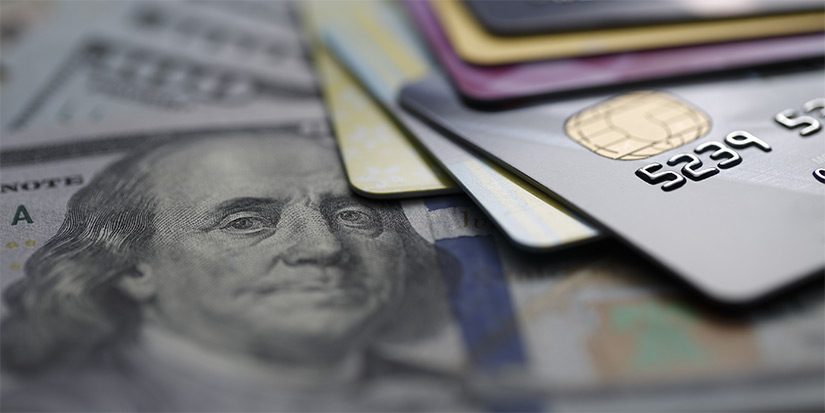
More COVID Relief Will Give an Added Boost to These 2 Stocks
- Robert Ross
- |
- The Weekly Profit
- |
- February 24, 2021
More COVID-19 relief could soon be on the way.
The House Budget Committee just approved a $1.9 trillion coronavirus aid bill. As things stand now, $1,400 in stimulus has been earmarked for most Americans.
Labor Department data shows that the $600 checks sent out in December went right to work in the economy. Retail sales jumped 5.3% in January, which was 5X higher than expected.
With the next round of individual stimulus more than twice as large as the last, it will add even more juice to the recovering economy. Plus, COVID-19 cases are declining. This one-two punch of positivity should have long-lasting effects.
The bond market agrees, as the 30-Year US Treasury bond has already risen 32% in 2021:
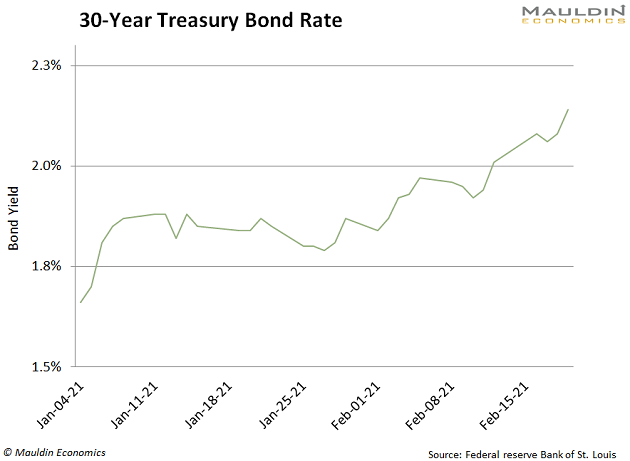
Long-term interest rates rise when investors expect higher economic growth and inflation. This jives with what other analysts are saying, including Goldman Sachs who expects 6.8% growth in 2021.
So which stocks benefit from both stimulus spending and rising long-term rates?
Let me show you.
Rising Interest Rates Mean Bigger Gains for These Sectors
While interest rates are rising, they are still near all-time lows.
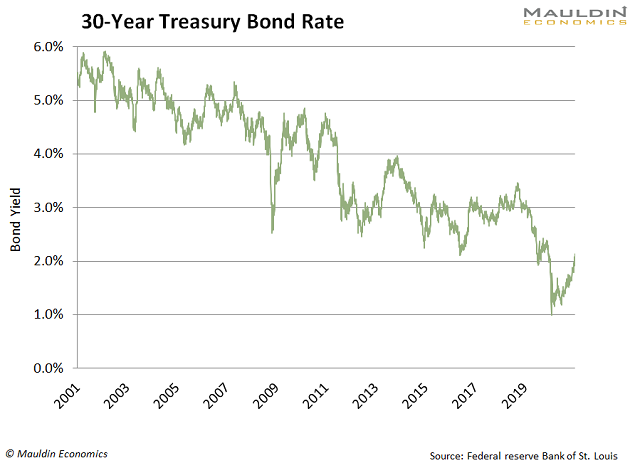
But an uptick in interest rates means certain “high yield” assets are less attractive. This makes sense, as investors would rather buy a risk-free government bond than a high-dividend-yielding stock.
Since 1990, the worst-performing sectors during a period of rising interest rates have been utilities, telecommunication services, and real estate investment trusts.
These sectors also pay the highest dividend yields:
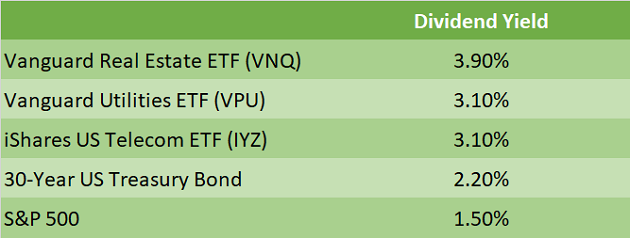
On the other hand, the best performers during this period were information technology companies:
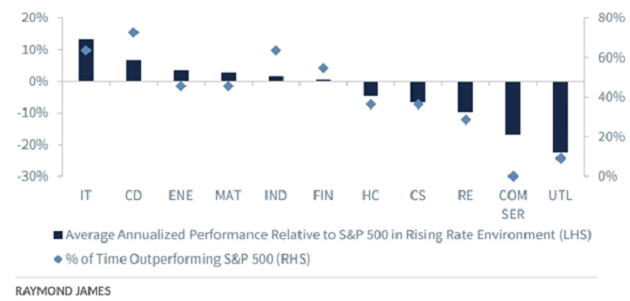
And while not a traditional utility, I know one tech sector that’s primed to benefit from both rising rates and stimulus spending: payment processors.
The Fastest-Growing Utility on the Planet
Payment processors are extremely similar to utility companies.
Just like someone who will turn on their lights no matter what, businesses will always pay tiny transaction fees to smooth the payment process.
That’s truer today than ever before, with the explosion in e-commerce sales in 2020.
Even though the US is in recession, consulting firm Deloitte expects holiday retail sales to rise 1.5% to $1.15 trillion between November and January.
The same study shows e-commerce spending will increase 30% year over year!
More people than ever are avoiding stores and shopping from the comfort of their couches. And payment processors like PayPal (PYPL) and Square (SQ) are well-positioned to benefit.
Their platforms help you move money from your online account to businesses’ accounts… seamlessly and securely. They make money every time you make a purchase from your favorite online merchants.
Just like an electric utility is the backbone of the energy grid, online payments are the backbone of the e-commerce market.
Even without stimulus money, that backbone is only getting stronger.
2 Trends Will Drive Digital Spending Higher in 2021
There are two major trends fueling online payments.
First, e-commerce spending is still only 10% of all US retail sales. Considering that COVID-19 is pushing more people to buy goods online, this trend shows no signs of slowing.
But the second is less obvious. For instance, a recent report from management consulting firm McKinsey showed that 71% of global transactions are still done with cash. That’s down from 86% in 2015.
And with the coronavirus still creating an urgent need for easy, contactless, and secure payments, that figure is only going to keep dropping.
This Trend Was Gaining Momentum Long Before COVID-19
Online payments saw double-digit global revenue growth (11%) for the first time in 2017. That figure grew another 6% in 2018 to hit $1.9 trillion in global revenue and should keep growing 6% annually.
At that rate, this market is expected to surge to $2.7 trillion by 2023:

And thanks to more customers shopping from home—and using online payment systems to do it—there is a lot more room for growth.
With long-term e-commerce growth plus the transition from cash to payment processors continuing, the future is bright for this sector… and for investors.
2 Ways to Get Paid from Online Payments
PayPal and Square are far from the only players in this increasingly lucrative space.
And my Equity Evaluation System (EES) tells me they may not even be the best ones.
This model uses 100+ criteria to find the best opportunities in US stocks. Not only does my EES system get my readers into the best stocks, but it also shows which “dogs” to stay away from.
- Right now, it’s telling me that one of the top ways to profit from the explosion in online payments is Visa (V).
As the world’s second-largest card payment company, Visa processes trillions of dollars in payments every year.
While the company pays a small dividend of 0.7%, the stock price should make up for any lost dividend income.
- Next on my EES ranking is Mastercard (MA).
As the world’s third-largest payments company, Mastercard processed $4.8 trillion worth of transactions in 2019. And while the company offers a mere 0.5% dividend yield, the long-term growth for the firm outweighs anything lost in dividend income.
Even with two coronavirus vaccines—and more to come—starting to hit the market, it will be many months before we get to go out and experience "business as usual" again.
The face-to-face economy will slowly make its comeback, but contactless payments will be forever. And Visa and Mastercard will be there, collecting a payout every time.

Robert Ross

